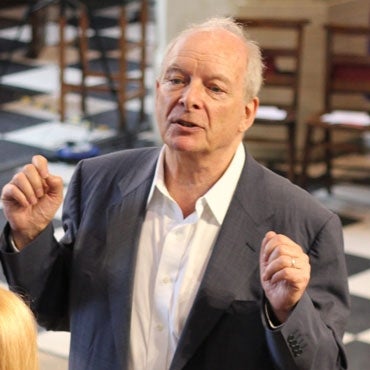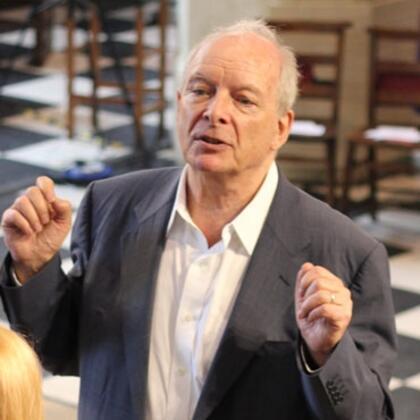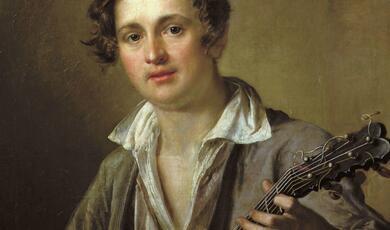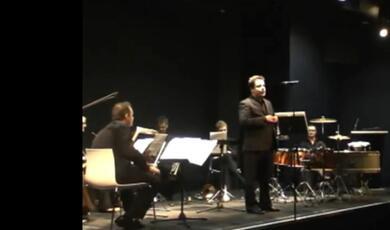Vienna and Schubert: The ‘Trout’ Quintet
Share
- Details
- Text
- Audio
- Downloads
- Extra Reading
Schubert Quintet in A, D.667 'Trout'
Eleanor Corr violin
Xin Xin Liu viola
Hannah Rose Innes cello
Jack Maran Hewetson double bass
Morta Grigaliunaite piano
This is a part of the series of lectures and concerts, European Capitals of Music.
Famous musical capitals provide the framework for this series of lectures with live music. The first three concentrate not only on 19th century Vienna, but on Schubert in Vienna and writing chamber music. Why did this music happen then, where was it played, who provoked, preformed and paid for it. And was it considered successful?
The final three ask similar questions of other capital cities: 20th century chamber music in Paris, baroque music in London under the shadow of Handel, and virtuoso violin playing in Rome focused on Corelli, the 300th anniversary of whose death is being celebrated this season.
The works in each programme are played by present members of the Royal Academy of Music.
Please note that a number of photographs taken at this event are available to be viewed on the Gresham College Flickr page.
Download Text
6 December 2012
Vienna and Schubert: The 'Trout' Quintet
Professor Christopher Hogwood CBE
Good afternoon, and welcome again to this fantastic baroque masterpiece. Like last time, I have to tell you all to suspend your interest in what you see around you, suspend your admiration of the best of British baroque, and put yourself into a quite different situation: a small Bedemeier music room in an Austrian house in the early nineteenth century.
Last time, I talked about the position of Vienna as the centre of the musical universe in the nineteenth century. I explained how that came about, outlining the various political, commercial, religious, as well as artistic reasons, and I also considered why it would no longer be possible to have such a concatenation of great names during a very short space of time, in one place. Just by the laws of statistics, you cannot again have Haydn, Mozart, Beethoven, Schubert all crammed into that small area, geographically and chronologically.
So, onto Schubert. What are our automatic reactions when we think of the typical early Romantic composer? How do these reactions compare to Schubert? We expect a Romantic composer to be: somebody who was obviously independent; probably quite difficult, not at all fond of taking orders from anybody; frequently very wildly possessed, either by inspiration or by alcohol or drugs, or by all three; probably without many social graces (a rather brusque sort of person, not an elegant salon composer); probably pretty intolerant of the technical and physical difficulties of performing the music that he wrote – an inspired mind is always way above the requirements of ordinary musicians' techniques. We think of somebody who is uniquely inspired – that is, we do not want to hear somebody who is good at turning out yet another cantata in the mid-Baroque idiom, but somebody who is speaking a unique language, separable from his neighbours and not to be mistaken for any other composer. Their message should not at all be derivative of any other composer or artist around. They are indebted to no one and usually badly dressed and quite often not very well-washed! Naturally, such a person leading a rather abnormal lifestyle might tend towards the revolutionary end of the scale, and would at least associate with young revolutionaries rather than the conservative elements. They would, obviously, forego such normal conventions as marriage, for example, and usually die young, probably of syphilis.
If you apply all of these conditions of the 'normal' Romantic composer to Schubert, the only one that actually fits with any credibility is, unfortunately, the last one – he did die young and it was probably from syphilis. But nearly everything else in that list of criteria that we expect to find exemplified by such composers, these things do not apply to Schubert.
He had, of course, as a young Romantic, a rather short composing life. There were really only fifteen years in which he was able to devote himself to composing. In that time, thinking about chamber music alone, he managed a total of fifteen string quartets, two piano trios, an octet and the "Trout" Quintet, which we will hear today. Do not forget his vocal music, 600 and more songs; neither must you forget the operas – you never see or hear them nowadays but there are quite a few. He produced church music, again rarely heard but there is lots of it. There is the keyboard music, and you do hear many of his piano pieces. For the last lecture, we heard that amazing F Minor Fantasy for four hands on one piano. And, of course, the symphonies. That is a lot in fifteen years.
In spite of what we have already considered about the commercial and aristocratic elements of the Viennese setting, it is important to remember that most of these works were not commissioned from Schubert, and very few of them were properly paid for. He did suffer, as all Romantics had to suffer, from cash flow anxiety (as it is called nowadays), which fits our picture of the Romantic composer fairly well.
Today, we have chosen a happy piece to perform. Not everything to do with Schubert was happy, but I thought it would be quite good to examine what he did in the case of two familiar works. We shall look at the song "The Trout", which was an all-time favourite even in his lifetime, and the Quintet that derives from it.
It is the result of a very nice summer holiday. When he was 22, he went on a walking tour around upper Austria, with one of his closest friends, Johann Vogl. Vogl was the singer who performed most of Schubert's songs at those Schubertiad evenings, so this was the man who probably sang at least 400 of those 600 songs. They were both young musicians. They finished their holiday in Vogl's home village, Steyr, where there was an alpine arts colony (of sorts). There, Schubert was introduced to Vogl's friend, the mainstay of the town. This was a man called Silvester Paumgartner, and he made his money, quite a lot of it, from having the monopoly on the iron mine that operated there. He also went out of his way to be an arts patron, held elaborate musical evenings, and, casting his eyes over Schubert, saw that he could commission a work from this young composer. Schubert, of course, agreed. This all sounds rather too beautiful and effortless; a composer was not supposed to just wander into a sunny village and immediately find himself commissioned to write a piece.
There were, however, two conditions that applied. One was that Paumgartner was already organising musical concerts with a group of his friends, and they had in mind a musical performance of the Hummel Septet. This is where it gets a little bit curious. This was a piece scored for piano, flute, oboe, horn, viola, cello and double-bass, a rather awkward combination. It is actually a fabulous piece, but even Hummel found that it was quite a difficult combination. He tried to oblige the public by reducing it so it could be played with by a piano quintet. However, this was not the normal quintet – that is, not a piano plus a string quartet, but a piano plus the instruments you see waiting patiently here. It is one of everything: one violin, one viola, one cello – all these you would expect to see. You would probably not expect to see the double-bass, which is not always a feature of chamber music groups, and certainly not of small chamber music groups like this. There is a theory that there was another Hummel piece which is a quintet, based on this group, and that influenced Schubert. You can discount this theory because we now know that it had not even been published - nobody knew it at the time that he wrote it. So, this musical evening was based around more music for this group which had already arisen from an adaptation of another composer's existing septet. It is rather a long trail to arrive at a rather unusual combination. The interesting thing is that Schubert immediately said yes – no standing on dignity and saying "I do not feel inspired to write for this extraordinary group, especially with an extraordinary double-bass in the middle of it." Instead, he took it on.
The second condition was that Paumgartner was very fond of the song "The Trout" and asked that some reference to this be included if possible - a set of variations. The problem with "The Trout", of course, is that it was already a very overworked song – it had been circulated in many versions. Poor Schubert, being asked to turn out yet another version of this over-exposed piece! Again, contrary to the Romantic model, he did not object in the least. He said, "Yes of course I can add references to "The Trout" song throughout the Quintet," and you can hear them in nearly every movement, "plus, I can add a set of variations on this theme, and we can find hidden depths, or at least new territories into which we can lead it."
The drawback for Schubert's career was that Paumgartner did play the piece with his friends, a little while later, after Schubert had written it and posted it to him from Vienna. As far as we know, he did pay, and as far as we know, that was it. It was not played again and it was not published until a year after Schubert was dead, which was ten years later. So, in fact, nobody else knew this Quintet at all.
This gives the work a very select position and shows the ease with which Schubert took orders from his patron.
There were other problems waiting for him, which all musicians are aware of. It is an unusual combination. It is not, as I said, a grouping of piano plus string quartet. It is usually quite easy to pick up a string quartet and add them to a piano and you are guaranteed many performances. There are many piano quintets for exactly that combination. There are hardly any for this rather difficult combination.
[To the musicians] Do you play any other quintet for this group? Did you have to do an awful lot of telephoning around and manipulating timetables to enable you to get together in this formation? There is nothing else for you to do except to be cast specifically for this. I think that is an initial, commercial drawback to the piece. There are other works written for quintet. There are actually two that pre-date this, so Schubert was not entering into this for the first time. Whether he knew the other pieces is doubtful. One is by John Kramer, written in 1803. There is another quintet for exactly this combination with bass by Ferdinand Ries, which he might possibly have come across. After that, it is "The Trout Quintet". Following on from this, you periodically get people who write new quintets for this grouping: Franz Limmer, Louise Farrenc (she wrote two), Hermann Goetz (I have never heard it), Tobias Picker (I have heard that and it is not my favourite quintet), and the most recent one I have found is by Stephen Butler, written in 1998. So, if you wanted to become a permanent "Trout Quintet" group, you have seven or eight pieces you could play.
But, within this group, there are in-built issues that the composer has to think about. Firstly, as I say, it has to be specially assembled. The other issue is the addition of the double-bass. It is nice to have, but it is operating in a range lower than you would normally expect to hear, competing with the left hand of the piano. If it is down there, that is the only competition there is. It does do one useful thing, which is to free the cello from being the bass of the structure. I think there was a reason for this because Silvester Paumgartner, who commissioned and paid for this piece, was the cellist! I think Schubert knew that pleasing your patron involved giving him the chance to shine, that is, not always plugging away on the bass line.
The problem with a group in which there is only one of everything is that you do not have the strength of the duet. Everybody knows that in a string quartet there are certain things that can only be achieved because you have two violins. They can mix together as one sound, they can answer each other, exactly in the same tessitura and style; there is a lot of dialogue, as well as tutti effects, that can be done with two of exactly the same instrument. Here, it is one against one, against one, against one. Additionally – and this is a problem that Hummel, the originator of the septet and the quintet version, did not overcome - the grand piano dominates. You run the risk of creating a piece that sounds like a miniature piano concerto throughout.
Schubert had to find a way of making sure that the piano did not obliterate the other instrument, and so it takes on a rather more restricted character, making it a melodic instrument. If you look at the first page of the piano part, nearly everything is written in octaves. So, the piano, instead of taking advantage of that full range of notes and the power to drown everybody out, to create a texture in which nobody else would be heard, takes a single melodic line, as though the piano was a simple melodic instrument.
Just play a little sample of what goes on…
[Music plays]
One has to remember that, for quite a lot of this piece, though not always apparent, the piano acts as an extra melodic line, not necessarily as an accompaniment or a concertante element or somebody who could take over the entire show. This is mark of Schubert's great discretion. It does lead to difficulties, which we can talk about later. Schubert often writes as though you had your thumb on the same side of both hands and you could just play up and down the piano in octave with the same finger. There is a certain intolerance of physical limitations towards the pianist, but this can be coped with. It makes a beautiful parrying sound, with few complexities. Against it, of course, you can have the self-sufficient piano that can play an accompaniment, or an accompaniment to its own solo line – there are variants. But you will find that most of the ensemble work is given with the piano playing in octaves.
When you write a sonata movement, there are certain implicit rules. You have an exposition, where you deliver two sets of ideas: first subject, second subject. They are in different keys, so the tonality is the home key, and then a second group, you modulate into the dominant, so you are operating on two different tonal levels. So, you begin in one key, you end up at the double-bar in a different key, and then comes what was called the fantasy in the nineteenth century – we call it the development section. Here, you go in all sorts of directions. Schubert is great at deceiving you about what key you are in. You will find, when we get to the mysterious moment in the middle, that everything starts to shift into keys – you cannot find your way through them, and I would defy most people to tell us, unless you have perfect pitch, exactly what tonality you are in. Everything has wandered.
When you come out the other end, you are supposed to then come back to the first group of themes, the first subjects. Then, by re-composing that link to the second group, you bring it into the same key, and so you end on a stable key, both the first group and the second group in the same tonality, ending where you began. That is the very simplified version of sonata form.
Schubert found a very ingenious way out of having to do any extra composing. He worked out that if that is the relationship of your keys at the beginning, if you fooled enough with the harmony in the fantasy section, nobody would know where they are, and so you can bring back the opening, higher, in the dominant, so that when that same modulation occurs, the second group will come out in the correct key to end. It is very easy for everybody to know when you have returned to the opening material, but few people, I think, would notice that it is officially in the wrong key. The simple reason for this is that Schubert was having a nice time and he did not want to be bothered with the chore of having to re-compose that link to change the relationship of these groups. You will probably spot it now that I have told you. Here is the whole of the first movement.
[Music plays]
I think nobody would suspect that this movement is based on a pretty universal cut-and-paste! Schubert would have loved the techniques available to composers with a computer today, allowing him to turn out yet more works by way of these subterfuges.
We shall now turn to the second condition set by Paumgartner, which is that "The Trout" song be included. It is good to know that there were five versions of "The Trout". This is a problem for musicians and musicologists: when you talk about "The Trout", which one are you referring to? Most people tend to think the last one is the one that the composer intended, but there is no evidence that Schubert thought it was any better than the others. The last version he wrote out - which is the one you have in facsimile, now in the Library of Congress in Washington DC - is the only version where there is a written introduction to it.
The introduction contains the fishy element. In the other four versions that Schubert wrote, there is no introduction there on the page, but that does not mean to say the composer did not improvise a little introduction – this was very normal. But the significant nuance of the song, and the thing that tends to stay in your head, is this little figure – just give us the little fishy figure…
[Music plays]
I do not know how long it took Schubert to dream that up or whether it just arrived spontaneously, but it has a wriggling sensation to it; the little chromatic inflection is absolutely perfect for setting the scene. That scene is innocent, you might think, until it turns nasty….
[Music plays]
You will notice that Schubert does not set the last verse of the song, which contains the moral. This is rather interesting. Does he think the moral is sufficiently obvious? Does he think that the drama of this subterfuge of muddying the waters is enough to show what the danger is, or does he perhaps not agree with Schubart's poetic moralising at the end? It is sometimes a bit confusing that we have Schubert, the composer, and Schubart, the poet, so closely connected.
The song, as I say, existed in five versions. It circulated, it was very well-known, and it has never been out of public consciousness. It is very memorable, very simple, and fairly moral. It crops up in so many places. One of the funniest instances I have come across is the recent Sherlock Holmes film, where Moriarty sings verses from "The Trout" while plotting the downfall of Sherlock Holmes. There is a nice twist at the end, in that the trout turns out to be a shark who actually eats the fisherman. I am also told, although I do not have personal acquaintance with this, that if you buy a certain Samsung spin-dryer, it sings "The Trout" at you when the spin load is dry and waiting for you to take it out! I think Schubert might have been quite amused by that! It seems that he was not, as I said, quite as high and mighty as the Romantic composer was supposed to be.
Anyway, this very well-worn song, even well-worn and well-known during Schubert's short lifetime, was what Paumgartner asked to form the basis of some part of his quintet. You have already heard certain elements, particularly that little rippling. The trout figure is there nearly all the way through this five-movement quintet, in one guise or other, but it is most obvious when you come to the set of variations.
Schubert places his set of variations, the condition for this commission as it were, in the 'extras' position – that is, when you have a normal symphonic work, you have an opening movement, which you heard, a very beautiful slow movement, a scherzo, and then you are waiting for the finale. It is that moment between the scherzo, or sometimes the minuet, and the finale which is where you put your extras. So, already, we know that Schubert felt these variations were not perhaps a prime element of a symphonic plan, but they were put in deliberately in this nice waiting position.
And then we can see what he decided to do with this melody. Let us go in order of obviousness: the first thing you could do is just simply take the song, give it to the violin, and the accompaniment to the piano, and this is what you would get.
[Music plays]
This is not the order in which Schubert delivers these ideas, but this is the sequence of obviousness. This forms the coda, so you do not get the origin of these variations until the very end. What you do have at the beginning though is quite an obvious idea: let us make something of a song to make it sound as though it was exactly suited to a string group, probably a string quartet, in a style that is almost identical with that of, for example, Haydn delivering the Austrian National Anthem, as the theme of the Emperor Quartet. This is a song delivered without any piano, just as a string unit.
[Music plays]
It looks as though the piano has been forgotten, so the next obvious thing to do is to reinstate the piano as top-dog, and to have the strings accompany.
[Music plays]
An important rule about writing to commission, which Schubert was well aware of: do not forget your patron! Paumgartner, who was paying for all this, was the cello, and so he had to then include something that shows the cello off in a slightly more flattering guise than merely decorating the tune. What happens in a cello variation is the cello takes "The Trout" melody and wanders off into new territories. This is no longer the song; this is an element of the song being set free.
[Music plays]
I think if I were Paumgartner, I would be very happy paying up for that!
One thing is missing. We have had a lot of solos and nice balance or imbalance organised between the instruments. Has there been a great deal of drama? No. So, insert a little drama quickly…
[Music plays]
A big contrast, in an almost hostile minor key, but not seriously present for very long. It is a beautifully designed foil for what is going to come afterwards, which is the final walk out, the coda, where, as we have already heard, the obvious treatment of the song is given to you (though piecemeal). It is very nice after that drama to be reintroduced to the original melody that we remember, with its not-quite-right accompaniment. Only gradually does it slip into the idiom that we all know is very safely the song, and that is the architecture of the coda which is so beautifully done.
It is difficult to write constantly happy music, and I think it is sometimes difficult for performers to know what to do with something like "The Trout", which is just happiness all the way through. With the variations, Schubert does give you some of the ideas that you need to look for, of withholding information, of adding drama, and of allocating specific roles to specific people which are then contradicted the next minute. The piano is one moment a sort of concerto soloist, and the next moment, it just adds little comments that ratify what is going on down here.
We have one instrument that needs to be heard, and that is the double-bass. There is one variation where it plays, just to prove that the double-bass can play the melody!
[Music plays]
It can be accompanied very decorously by the strings…
[Music plays]
This is just to show Schubert breaking his own rule now. You thought this was the moment to admire the double-bass player supported by the cello, but in fact, the piano has a part in this variation too, and it is showy; in the end, nobody listens to anything really except the piano. Put it altogether and we are sufficiently distracted from the double-bass.
[Music plays]
Put all these elements together in a different sequence and you have this extra movement, the variations on "The Trout" itself, which we end with today. The complete movement, thank you.
[Music plays]
© Christopher Hogwood CBE 2012
Part of:
This event was on Thu, 06 Dec 2012
Support Gresham
Gresham College has offered an outstanding education to the public free of charge for over 400 years. Today, Gresham College plays an important role in fostering a love of learning and a greater understanding of ourselves and the world around us. Your donation will help to widen our reach and to broaden our audience, allowing more people to benefit from a high-quality education from some of the brightest minds.


 Login
Login









